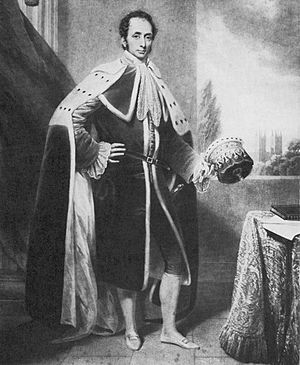Philip Henry Stanhope, 4th Earl Stanhope facts for kids
Philip Henry Stanhope, 4th Earl Stanhope (born December 7, 1781 – died March 2, 1855) was an English nobleman. He is mostly remembered for his part in the mystery of Kaspar Hauser during the 1830s.
Family Background
Philip Henry Stanhope was the oldest son of Charles Stanhope, 3rd Earl Stanhope (1753–1816). His mother was Louisa Grenville (1758–1829). Louisa was the daughter of Henry Grenville, who had been a governor and an ambassador.
His Life and Work
Philip Henry Stanhope used the title Viscount Mahon before he became an Earl. He was a Member of Parliament (MP) for the Whig party. An MP is a person elected to represent an area in the government. He served for different areas from 1806 to 1812. In 1816, he became an Earl and joined the House of Lords, which is a part of the British Parliament.
Like his father, he was interested in science. He became a Fellow of the Royal Society in 1807. This is a group for important scientists. He also led a society that studied plants for medicine and was a vice-leader of the Society of Arts.
People often thought he was a bit unusual or quirky. This was like his half-sister, Lady Hester Stanhope. He had studied in Germany and traveled a lot in Europe. He met many royal families during his travels.
His daughter, the Duchess of Cleveland, wrote that his own father did not send him to school. Instead, he kept him at home. His father wanted Philip to agree to sell the family lands. This would have made the family poor. But Philip's sister, Hester, helped him escape. Important people like William Pitt the Younger were happy about what she did.
The Kaspar Hauser Mystery
Lord Stanhope became very interested in the story of Kaspar Hauser. Kaspar was a young man who appeared in Nuremberg in 1828. He became famous because he claimed he had been kept alone in a dark room his whole life. He said he knew nothing about who he was.
In 1829, Kaspar Hauser was found with a cut wound. He said a hooded man had attacked him. This led to many rumors. Some thought he might be a prince. Others thought he was pretending.
Lord Stanhope gave Kaspar Hauser money and paid for searches in Hungary. Kaspar had said he remembered some Hungarian and Slavic words. This made people think he might be from Hungary. But the searches did not find anything.
In December 1831, Lord Stanhope became Kaspar Hauser's foster father. He moved Kaspar to live with a schoolmaster. Stanhope went back to England in 1832. He kept writing to Kaspar and to officials working on the case.
Stanhope first thought Kaspar was from a noble Hungarian family. But he changed his mind when more searches in Hungary failed. In a letter from 1832, Stanhope said he doubted if Kaspar was telling the truth.
He kept paying for Kaspar's living costs. But he never brought Kaspar to England as he had promised. His letters to Kaspar became less kind. Kaspar noticed this change.
On December 14, 1833, Kaspar Hauser came home with a deep wound in his chest. He claimed a stranger had stabbed him. He died three days later.
Even though Stanhope had stopped believing Kaspar's stories, he first thought Kaspar had been murdered. He wrote this in a letter. But after getting more information, he changed his mind again. He later believed that Kaspar had accidentally hurt himself. He thought Kaspar had tried to make a small wound to get attention, but it went deeper than he meant.
Some people who supported Kaspar Hauser blamed Lord Stanhope. They even said he caused Kaspar's death. They thought Kaspar was a prince from Baden and was killed for political reasons. However, some historians defended Lord Stanhope. They saw him as someone who wanted to find the truth but was tricked.
Family Life
On November 19, 1803, Philip Henry Stanhope married Catherine Lucy Smith. She was the daughter of Robert Smith, 1st Baron Carrington. They had two sons and one daughter:
- Philip Stanhope, 5th Earl Stanhope (1805–1875), who became a historian.
- Hon. George Joseph Stanhope (1806–1828), who was a diplomat and died in Brazil.
- Catherine Lucy Wilhelmina Stanhope (1819–1901), also a historian. She was known as the "Duchess of Cleveland." She married twice:
- First to Archibald Primrose, Lord Dalmeny (1809–1851). They had children, including Archibald Primrose, 5th Earl of Rosebery, who became Prime Minister of the United Kingdom.
- Second in 1854 to Harry Powlett, 4th Duke of Cleveland (1803–1891). They did not have children.


